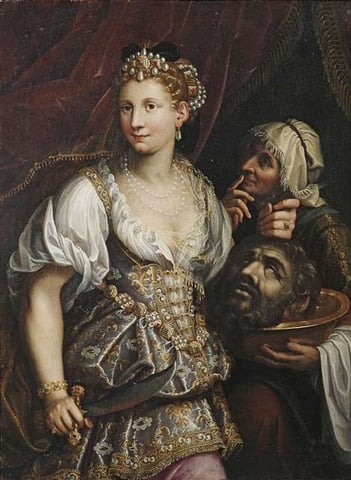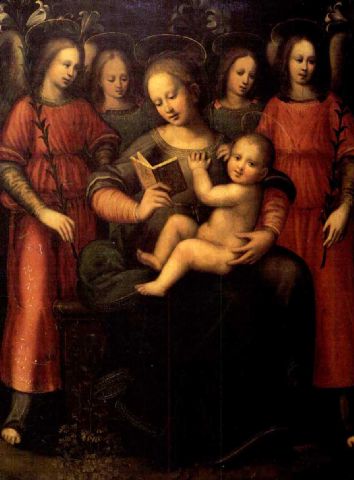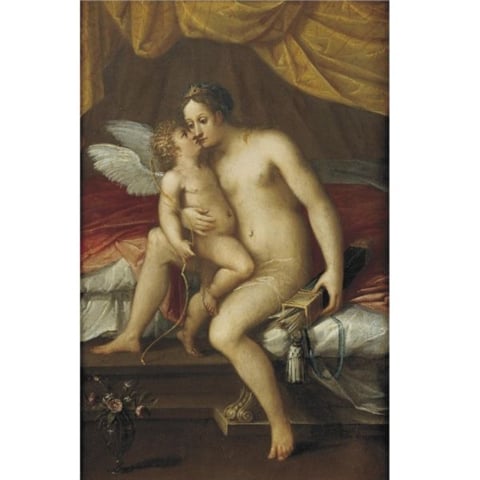Galleries
Women Painters during the Italian Renaissance
Read the stories of female painters during the Italian Renaissance.

Read the stories of female painters during the Italian Renaissance.

Tara Field

More female painters existed during the Renaissance than is immediately apparent, and more and more of their stories are being unveiled and recounted.

Workshop of Fede Galizia, Judith mit dem Haupt des Holofernes, oil on canvas, sold at Nagel Auktionen, Stuttgart, Germany
During the Italian Renaissance, art was a social necessity, particularly because a majority of the population was illiterate and relied on visual imagery for spiritual guidance. Spirituality played a large role in Renaissance society in part because of the ever-present threat of death, whether by disease or political instability. There was no telling when a war might break out or half the population would be killed by the Plague. For women, the threat of death was even more prevalent. Women were born to be married off, usually in order to strengthen familial ties. Once married, a woman was then expected to bear as many children as she could. Unfortunately, without modern medical technology, labor complications all too often ended in premature death.
Considering the social and cultural limitations, it is surprising that Renaissance women had the opportunity to do anything besides fulfill their duties as wives and mothers. The social contract of the time did not allow women to hold any occupation outside of the home, unless it was in a convent. Convents could be a liberating alternative to marriage as places where women could learn how to read and paint, and where they could participate in activities that might otherwise have been unavailable to them.
One of the earliest-known female artists of the Renaissance was a nun known as Saint Catherine of Bologna, or Caterina de’ Vigri. After her death, her body was exhumed and preserved for display. To this day, Saint Catherine sits on a chair in a chapel in Bologna, surrounded by her creations.
Another monastic painter from the Renaissance who is steadily regaining recognition is Plautilla Nelli (1523–1588). Painter and historian, Giorgio Vasari (Italian, 1511–1574), wrote extensively about Renaissance artists, but only ever mentioned four women, and Nelli was one of them. She trained in the style of Fra Bartolomeo (Italian, 1472–1517), whose works were passed down to her by his student, Fra Paolino (Italian, b. ca.1490–1547). Her work, Lamentation, was inspired by similar compositions by Fra Bartoloemeo and Perugino (Italian, b. ca.1450–1523). Nuns who learned how to paint during the Renaissance typically had unorthodox training, and their unique style often resulted in something similar to the contemporary understanding of Folk, Naïve, and Outsider Art. One such example of this can be seen at the monastery at Santa Maria Novella in Florence, which houses Nelli’s grand painting of the Last Supper. Traditionally, this subject was commissioned for the refectory (dining hall) of a convent or monastery, as was the case with Leonardo da Vinci’s famous Last Supper. In spite of her technical skill, the subtly feminine physical traits of the apostles betray Nelli’s lack of familiarity with the male body. Indeed, it was not until the 19th century that female artists were permitted to study figure drawing from live subjects.

Plautilla Nelli, Madonna con bambino e quattro angeli, oil on board, sold at Sotheby’s Florence
Apart from joining a convent, women also learned how to paint through their fathers. Male artists often taught their daughters to work for them in their workshops, and several notable female artists began their careers this way, including Lavinia Fontana, Barbara Longhi, Marietta Robusti (Tintoretto’s daughter), and Fede Galizia.

Attributed to Lavinia Fontana, Venus and Cupid, oil on panel, sold at Sotheby’s New York
Perhaps one of the most fascinating female painters of that time period was Sofonisba Anguissola (Italian, 1532–1625). Unlike many other female artists of that era, she was not the daughter of an artist nor did she become a nun; instead, her father encouraged her, and the rest of his children, to develop their talents in the arts (several of her sisters also became painters). She experimented with new kinds of portraiture in which the subjects were posed informally or engaged in an activity. Her most famous work of this type is of her siblings entitled Lucia, Minerva and Europa Anguissola Playing Chess, which is in the National Museum in Poznan, Poland. Her talent was recognized by many well-known figures of the day, including Michelangelo (Italian, 1475–1564) and Vasari, who documented her praises. She became court painter and lady-in-waiting to the queen of Spain, whom she also taught how to paint. Unlike most of her female contemporaries, Anguissola was given the opportunity to have a career, and did not get married until she was nearly 40 years old.

Attributed to Sofonisba Anguissola, Self Portrait, oil on canvas, sold at Christie’s New York
In recent years, considerable resources have been dedicated to unearthing the details of these talented women and making their stories heard. Works by Renaissance women are being uncovered in museum archives, conservation studios, and at auction.